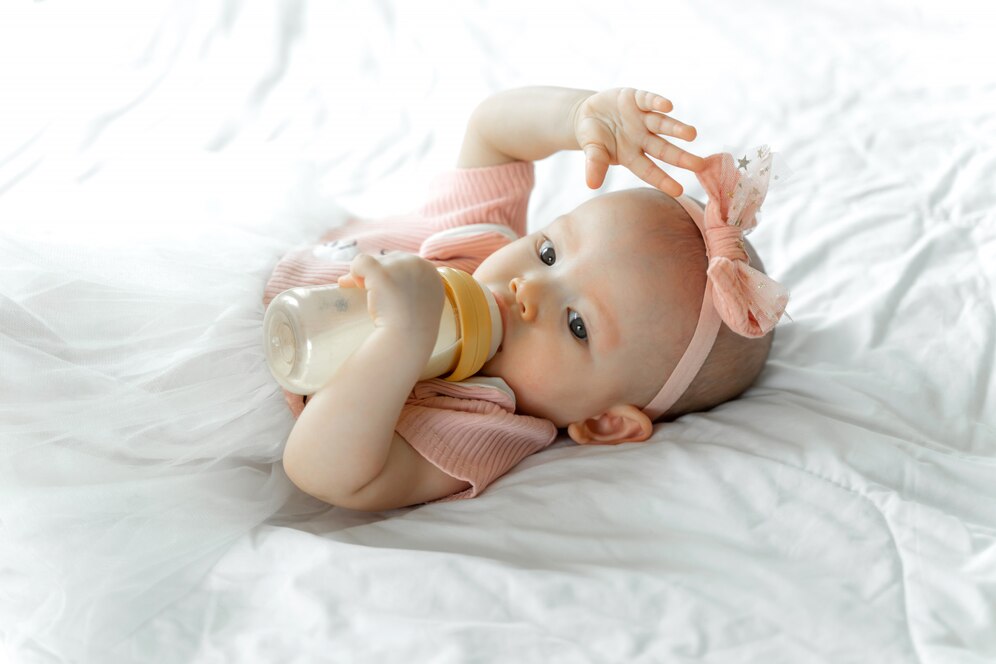When it comes to feeding your baby, choosing the right baby bottle is a crucial decision that can impact your little one’s comfort and well-being. With a variety of options available in the market, it’s essential to understand the features, materials, and considerations that go into choosing the most suitable baby bottle for your baby’s needs. In this comprehensive guide, we’ll explore the key factors to consider when selecting baby bottles and provide insights into the various types available.
I. Types of Baby Bottles:
A. Standard Bottles:
- Materials: Typically made of plastic, glass, or stainless steel.
- Features: Straightforward design, easy to clean, and available in various sizes.
- Pros: Affordable, lightweight, and durable.
- Cons: Some plastic bottles may contain BPA; glass bottles can be heavier and breakable.
Standard baby bottles are available in a variety of materials, including plastic, glass, and stainless steel. They feature a straightforward design, making them easy to clean and maintain. These bottles come in various sizes, providing flexibility for different feeding needs. While plastic bottles are affordable and lightweight, it’s essential to choose BPA-free options. Glass bottles offer durability but can be heavier and prone to breakage. Stainless steel bottles are a durable and chemical-free alternative, though they tend to be heavier than their plastic counterparts.
B. Anti-Colic Bottles:
- Materials: Commonly made of plastic or glass.
- Features: Designed to reduce air intake, minimizing the risk of colic and gas.
- Pros: Can alleviate common feeding issues; suitable for infants prone to colic.
- Cons: May have more components to clean; some babies may not benefit significantly.
Anti-Colic Bottles designed to minimize air intake during feeding, anti-colic bottles aim to reduce the risk of colic and gas discomfort in infants. These bottles typically come in plastic or glass variants and often incorporate features such as special venting systems or unique nipple designs. While they can be beneficial for babies prone to colic, it’s important to note that they may have more components to clean compared to standard bottles.
C. Wide-Neck Bottles:
- Materials: Available in plastic, glass, or silicone.
- Features: Wider design mimics the breast, facilitating an easier transition between breast and bottle.
- Pros: Easier to clean due to wider openings; suitable for breastfed babies.
- Cons: May be bulkier and less travel-friendly.
Wide-neck baby bottles mimic the breast’s shape, making them an ideal choice for infants transitioning between breast and bottle feeding. Available in plastic, glass, or silicone, these bottles feature a wider design that facilitates easier cleaning due to larger openings. While they may be bulkier compared to standard bottles, their design is advantageous for breastfed babies or those who prefer a broader latch.
D. Disposable Bottles:
- Materials: Typically made of plastic.
- Features: Pre-sterilized and ready to use; convenient for travel.
- Pros: No need for cleaning; convenient for on-the-go feeding.
- Cons: Can be more expensive over time; environmental impact due to disposable nature.
Disposable baby bottles offer convenience, especially for on-the-go feeding. Typically made of plastic, these bottles come pre-sterilized and ready to use, eliminating the need for cleaning. While they are convenient for travel, the long-term cost can be higher compared to reusable bottles, and their disposable nature raises environmental considerations.
II. Considerations When Choosing Baby Bottles:
A. Material Safety:
- Plastic Bottles: Opt for bottles labeled as BPA-free to avoid potential harmful effects.
- Glass Bottles: Provide a safe and non-toxic alternative, but they can be heavier and breakable.
- Stainless Steel Bottles: Durable and free from potential chemical leaching; heavier than plastic.
Ensuring the safety of the bottle materials is paramount. BPA-free plastic bottles are a safe choice, and glass bottles provide a non-toxic alternative. Stainless steel bottles are durable and free from potential chemical leaching. Choosing a material depends on individual preferences and priorities regarding safety and durability.
B. Nipple Material:
- Silicone Nipples: Soft, durable, and easy to clean; suitable for most babies.
- Latex Nipples: Softer and more flexible but may not last as long; potential for latex allergies.
Baby bottle nipples are commonly made from silicone or latex. Silicone nipples are soft, durable, and easy to clean, making them suitable for most babies. Latex nipples are softer and more flexible but may not last as long, and there is a potential for latex allergies.
C. Flow Rate:
- Slow Flow: Suitable for newborns to prevent overfeeding and reduce the risk of choking.
- Medium Flow: Ideal for infants a few months old.
- Fast Flow: Suited for older babies who can handle a faster milk flow.
Consider the flow rate of the bottle nipple, as it directly impacts the feeding experience. Slow-flow nipples are suitable for newborns to prevent overfeeding, while medium-flow and fast-flow nipples cater to older babies who can handle a faster milk flow without choking.
D. Ease of Cleaning:
- Bottle Design: Choose bottles with simple shapes and wide openings for easier cleaning.
- Anti-Colic Systems: Consider whether the anti-colic features add complexity to the cleaning process.
The design of the bottle plays a crucial role in ease of cleaning. Bottles with simple shapes and wide openings are generally easier to clean. Anti-colic systems may add complexity to the cleaning process, so it’s essential to weigh the benefits against the maintenance effort.
E. Compatibility with Breastfeeding:
- Breast-Like Nipple: Select bottles with nipples that mimic the breast for an easier transition between breast and bottle.
- Wide-Neck Bottles: Suitable for babies who switch between breast and bottle frequently.
For mothers who breastfeed, choosing a bottle with a breast-like nipple can ease the transition between breast and bottle. Wide-neck bottles, designed to mimic the breast’s shape, are particularly suitable for babies who switch between breastfeeding and bottle feeding.
F. Budget Considerations:
- Cost of Bottles: Evaluate the overall cost, considering whether the bottles are sold individually or in sets.
- Long-Term Use: Assess the durability and potential longevity of the chosen bottles.
Evaluate the overall cost of the bottles, considering factors such as the cost of individual bottles or sets. Additionally, assess the durability and potential longevity of the chosen bottles to determine their long-term value.
III. Additional Tips for Baby Bottles
- Sterilization
- Check for Wear and Tear
- Transitioning Between Bottles
- Sterilization: Ensure bottles are sterilized before first-time use, following the manufacturer’s guidelines. Regular sterilization helps maintain a hygienic feeding environment.
- Check for Wear and Tear: Regularly inspect bottles and nipples for signs of wear, cracks, or damage. Damaged components should be replaced promptly to ensure the baby’s safety.
- Transitioning Between Bottles: Be patient if your baby takes time to adjust to a new bottle. Gradual transitions, such as introducing the new bottle during a calm feeding session, can help ease the adjustment process.
Conclusion:
Choosing the right baby bottle involves a careful consideration of various factors, from material safety to the baby’s age and feeding preferences. Understanding the options available and assessing your baby’s needs will help you make an informed decision. Remember that every baby is unique, so finding the bottle that aligns with their comfort and your practicality is key to ensuring a positive feeding experience.


